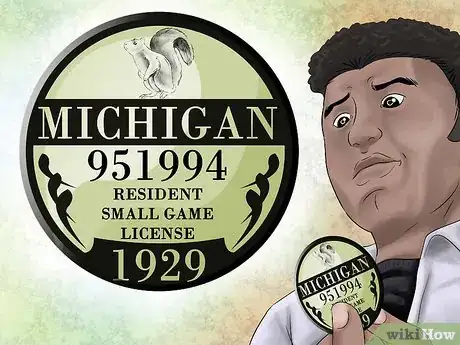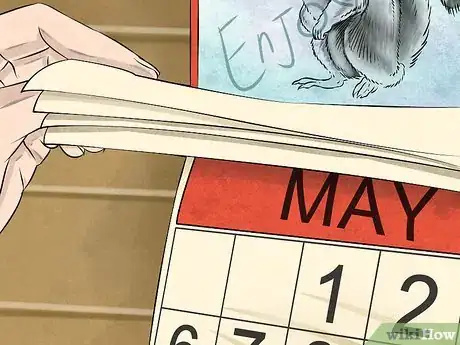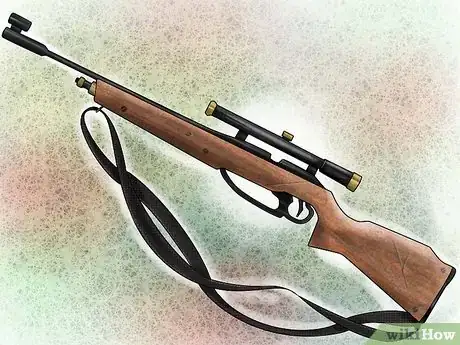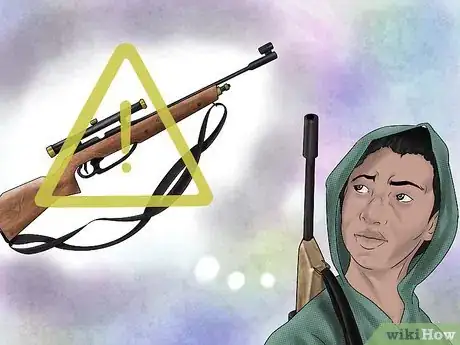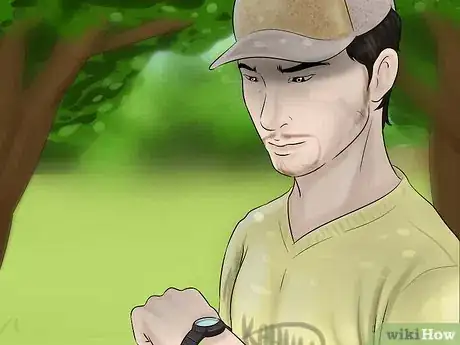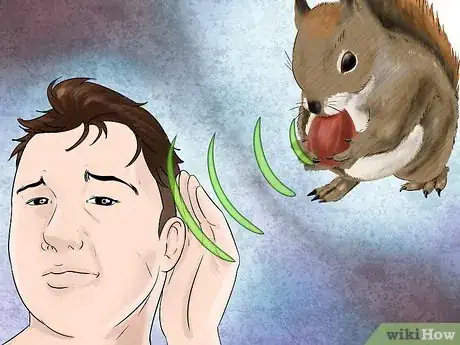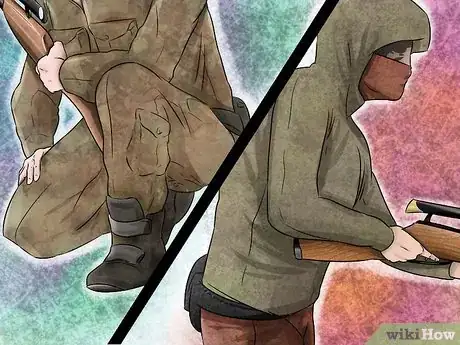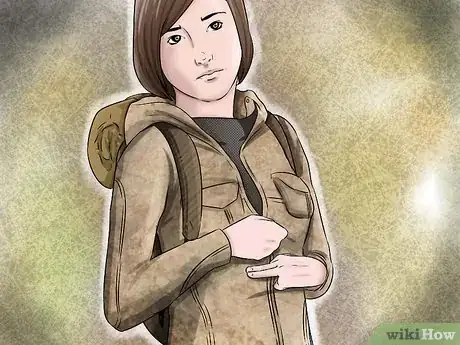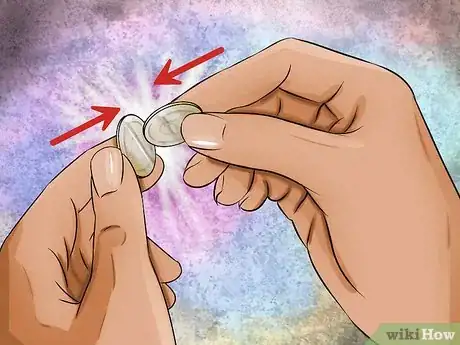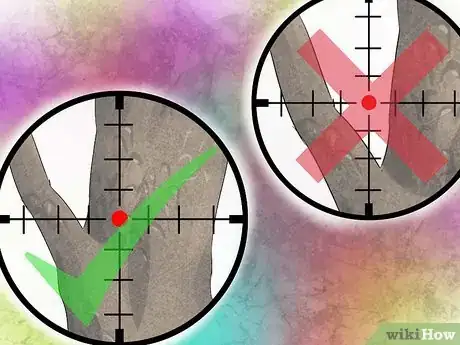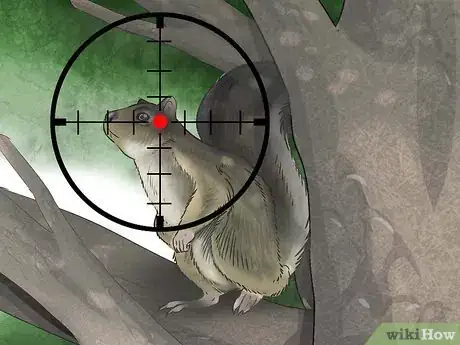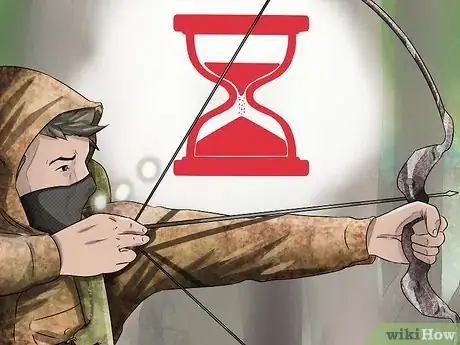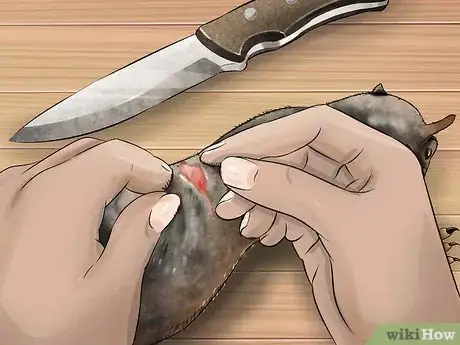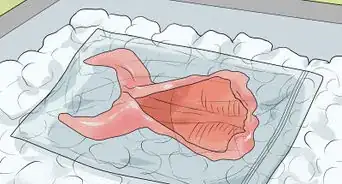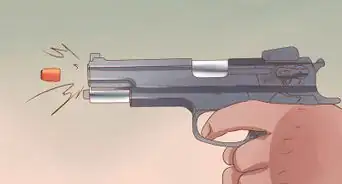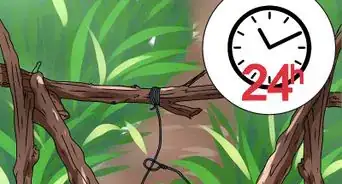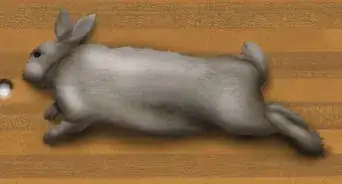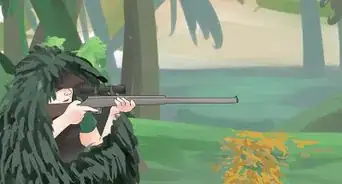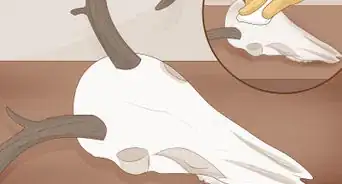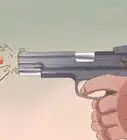wikiHow is a “wiki,” similar to Wikipedia, which means that many of our articles are co-written by multiple authors. To create this article, 56 people, some anonymous, worked to edit and improve it over time.
wikiHow marks an article as reader-approved once it receives enough positive feedback. In this case, 86% of readers who voted found the article helpful, earning it our reader-approved status.
This article has been viewed 308,921 times.
Learn more...
Many young hunters get their start by hunting squirrels with more manageable .22 caliber firearms. Many people may think hunting squirrels should be easy, but due to the emphasis on quiet movements and precision shots, one expert even called squirrel hunting, "deer hunting in miniature."[1] With the right licensing, preparations, and tactics, you can prepare for your state's next squirrel hunting season.
Steps
Preparing for the Hunt
-
1Obtain a small game license. Squirrels are categorized as small game in most states (interestingly they are classed as vermin in the UK) and are therefore subject to the statutes pertaining to small game hunting. Obtaining a small game license in any given state usually entails filling out a form with your address, a driver’s license number, and other information, as well as paying a small fee.
- Though small game licenses aren’t usually as regulated, many states only grant a specific number of certain license types each year, so you may want to pay attention to the date your state begins accepting license applications for the year.
- For any questions you have regarding licensing, seasons, limits, etc. contact the proper governing body in your state. Each state’s hunting regulatory department goes by a different designation as well. For instance, in Nevada, it is the Nevada Department of Wildlife,[2] whereas New York’s equivalent is the New York State Department of Environmental Conservation.[3]
-
2Research what squirrels you can hunt. Many states additionally regulate the specific breeds of squirrel you can hunt in any given season. In South Carolina, for instance, you can hunt gray squirrels, but many areas do not permit the hunting of fox squirrels.[4]
- These specific regulations vary by state and region based on existing populations.
- Many states may also differentiate between squirrel breeds that require a license at all. For example, the California Fish and Game Code classifies ground squirrels as non-game mammals, which can be hunted without a license if they are a nuisance to crops or property; however, all tree squirrels in the state are classified as small game and require the proper license.[5] If you want to hunt squirrels on your own property because they are damaging your home or property, then check with your state’s regulatory department for specifics. This may require having a professional out to identify the breed as well.
Advertisement -
3Observe proper hunting seasons. Each state will additionally observe widely varying seasons when it comes to squirrel hunting. For example, squirrel hunting season starts in Virginia in September, but in Missouri, it starts much earlier at the end of May.
- Also pay special attention to “no firearm” seasons, during which you can hunt squirrels with dogs, but being caught with a firearm on your person is illegal.
-
4Familiarize yourself with bag limits. In addition to when you hunt, states also regulate how much you can hunt. Bag limits are usually posted as daily limits, and these also vary by state. As examples, New York state and Virginia set a daily bag limit of six squirrels,[6] whereas Missouri sets a higher daily limit at ten.
-
5Choose your weapon. There are several different choices suitable for squirrel hunting; however, you state may regulate the type of weapon you can use, and they may also require you to specify your weapon type on your license application. Make sure that you only use weapons you are comfortable with, licensed to use, and for which you know how to handle safely. Options for squirrel hunting include:
- Bow and Arrow - Archery is the hunting technique that involves the most skill. Learning to shoot a bow is not an easy task, and mastering it takes a very large amount of dedication and practice. Archery may be tough, but it is also one of the best ways to hunt squirrel. It is virtually silent, even quieter than air guns, so you can often hunt an entire family of squirrels without them realizing it. And the arrows are usually reusable unless you break them, and are very modular as far as the tips go. There are several different types of arrows you can use. Straight limb is a low-power type of bow usually found homemade or in youth archery departments. Recurve is a higher-power type of bow that is very accurate but is harder to draw and hold back. Compound bows are very high powered, easy to hold back, and their accuracy can be punishing, but they are very expensive, require a lot of maintenance, and are very sensitive to shock damage (they don’t take kindly to being manhandled).
- Air Rifle - Air rifles are inexpensive and effective if fired with good accuracy. They are also very quiet, making it the weapon of choice for suburban squirrel haters. A simple .177 daisy pellet rifle can be bought from Walmart or some gun stores for around $50.00, and higher quality ones can set you back a lot more. Either way you go, you should experiment to find the the type of pellet your gun shoots most accurately since precise pellet placement is more important than minor differences in pellet penetration or expansion.Pellet rifles require top-notch shooting on the part of the hunter because a wounded squirrel can usually still climb a tree. Pellet rifles usually work better for this.
- .22 caliber firearm - The .22 caliber is probably the most commonly used cartridge for squirrel hunting. The small size prevents overkill that destroys a lot of meat. The long range and high accuracy gives it the ability to hit squirrels from much further away than air rifles, shotguns, and archery. Many .22 caliber weapons are also auto loading, giving you the ability to get that quick follow-up shot if needed.[7] However, like any firearm (or any projectile flinging apparatus for that mater) it is only as good as the shooter behind the sights. The point of impact is only .22 in. Accuracy counts in a very big way, but that is part of the challenge that draws people to this sport.
- Shotgun - If what you desire is a larger spread, look no farther than the shotgun, although you will have to be closer to your quarry than the .22 can get you. If you choose to hunt with a shotgun, the recommended shot size if 5 or 6 on a shotgun with a 28” or 30” barrel length. Shotgun shells tend to be more expensive than other ammo, and they take up a lot of space in your gear. The large recoil may limit some smaller-built hunters in endurance as well. Shotguns are also louder and meaner sounding than .22s and air rifles, meaning that you are more likely to spook squirrels in the area.
-
6Take all of the proper safety precautions. Whatever weapon you choose, you should ensure that you get plenty of practice with it in a safe, controlled environment before trying to hunt with it. Familiarize yourself with the safety setting on each weapon, and ensure that it’s always on except when you are ready to shoot.
- Additionally, keep your weapon shouldered or pointed at the ground with your finger outside the trigger guard except for when you are ready to shoot.
- Never point a weapon at anything unless you intend to shoot it.
- Remember that an arrow can be just as dangerous as a bullet, so take all safety precautions with a bow as well.
- For more information on gun safety, check: How to Handle a Firearm Safely
Hunting Squirrels
-
1Choose a good time to hunt. Squirrels are most active during daylight hours, and both morning and late afternoon can prove very productive times to hunt squirrels.[8] Many squirrel hunting seasons start around late summer or early fall, so time of the year plays a part as well. You can use the rustling of not yet fallen leaves to help you locate squirrels in trees, though the same leaves that give away their position help to camouflage them as well.
-
2Choose the right area to hunt. Squirrels especially love acorns, beechnuts, and hickory nuts. By looking for oak, beech, and hickory trees, you’re much more likely to find yourself in areas of higher activity.[9]
-
3Look and listen for evidence of cutting. Cutting refers to the grinding noise you’ll hear that is evidence of a squirrel cutting the husk off the nuts it eats, and it is followed by the paired noise of the same husks typically falling through the leaves of the tree and hitting the ground. By looking and listening for the evidence of squirrel cutting, you can pick a great spot to set up shop and wait.
-
4Choose whether to wait or stalk. The two main camps for squirrel hunting are those who play the waiting game and those who decide to stalk the squirrels.[10] If you choose the right spot to set up, then waiting can be productive; however, many experts have more luck taking a stalking approach since you can follow the telltale signs of squirrel cutting.
- Regardless of your approach, patience is the name of the game. If you choose to stalk, you must still move very slowly and quietly. Only take two or three steps at a time, and then pause to listen for movement.[11]
-
5Use ground camouflage. Camouflage clothing is very useful. If you can afford or make a ghillie suit, even better. But a blind of some sort is invaluable, even if it is just a log you are hiding behind. Squirrels that live in the forest are extremely shy, and if you can get within 15 yards (13.7 m) of one, you are doing extremely well. So, to get close to the squirrels, you will have to set up in an area that you can easily camouflage. You will want to be able to move to a shooting position with as little disturbance to the area around you as possible. If you have a hunting buddy, you should have them stand a few yards out to see if they can spot you lying in wait, as well as moving to a shooting position.
-
6Mimic squirrel noises. If squirrels hear unfamiliar noises, they tend to pause for long periods in their trees to wait for the potential danger to pass.[12] By mimicking the noise of other squirrels eating, you can convince the frozen squirrels nearby that they’re okay to resume their business.
- One easy way to mimic the sound of squirrel cutting is to take two quarters—one flat and the ribbed edge of the other against it—and rub them together with a bit of pressure. This very similarly replicates the grinding noise of squirrel cutting.
- A second way to mimic squirrel noise is to drop your hand into the litter beneath an oak tree and rustle the leaves there at random intervals.[13] Repeat this without making any other noise at all.
-
7Set a trap for the squirrel. A variety of different traps and trapping methods are available for squirrels as well; however, states also highly regulate squirrel trapping, so contact your state’s regulatory department to find out what trapping methods—if any—are permissible in your state.
-
8Make safe shots. Shooting into a tree for a squirrel always means shooting upward, so you want to make sure you take safe shots. You want to aim in such a way as to ensure that the bullet hits the tree if you miss.[14]
- You will also have an easier time making safe, precision shots if you always keep the sun to your back as you stalk.[15]
-
9Aim for the head. In order to kill the squirrel in one shot, as well as to preserve as much of the meat as possible, you want to aim for the head.[16] Squirrels are, well, squirrelly, and hitting one someplace other than the head may give it time to get further up the tree or into a hole before you can aim for your second shot.
-
10Be patient. Take your time waiting for the squirrels and setting up the shot, especially if you are a new hunter. Moving too quickly may make more noise and shooting too quickly may cause you to miss your shot. Missed shots, as well as any noise you make, can scare the squirrel away. After a shot, you may have to wait as long as half an hour before a squirrel comes out of hiding.
-
11Clean your kills. After successfully hunting a squirrel, you’ll need to skin and gut it in order to preserve the meat. You can learn all about the process for cleaning a squirrel at: How to Clean a Squirrel.
Community Q&A
-
QuestionWhere should I shoot a squirrel if I want to stuff it?
 Community AnswerIdeally in the chest, as this will create minimal damage and you can easily sew the hole shut. A headshot would damage the head and would be difficult to restore.
Community AnswerIdeally in the chest, as this will create minimal damage and you can easily sew the hole shut. A headshot would damage the head and would be difficult to restore. -
QuestionCould an 800 fps airgun punture a squirrel's skull?
 Travis BondCommunity AnswerAt around 10 to 20 feet 800 fps would do the job, but any further I would suggest a 1000 fps.
Travis BondCommunity AnswerAt around 10 to 20 feet 800 fps would do the job, but any further I would suggest a 1000 fps. -
QuestionThe squirrel I shot at jerked his tail and ran away. Does this mean I hit him?
 Community AnswerNot necessarily, the squirrel may have just been startled by the sound of the gun. If the squirrel was in a tree, it would have fallen if you hit it.
Community AnswerNot necessarily, the squirrel may have just been startled by the sound of the gun. If the squirrel was in a tree, it would have fallen if you hit it.
Warnings
- Remember that archery equipment is just as dangerous as a firearm.⧼thumbs_response⧽
- While hunting is one of the safest sports, it is the responsible behavior of hunters themselves that make it that way. Hunting can be very dangerous.⧼thumbs_response⧽
- Be aware of the rules of safe firearms handling and follow them. Always keep your finger off the trigger until ready to shoot, and never point the weapon at anything you are not willing to kill or destroy.⧼thumbs_response⧽
- Shooting Red Squirrels in the UK is illegal.⧼thumbs_response⧽
References
- ↑ http://www.fieldandstream.com/articles/hunting/small-game/when-hunt-rabbits-squirrels-and-other-small-game/2009/09/stalking-squirr
- ↑ http://www.ndow.org/
- ↑ http://www.dec.ny.gov/outdoor/29460.html
- ↑ http://www.dnr.sc.gov/wildlife/species/foxsquirrel.html
- ↑ http://www.ipm.ucdavis.edu/PMG/PESTNOTES/pn7438.html
- ↑ http://www.dec.ny.gov/outdoor/29460.html
- ↑ http://www.outdoorlife.com/blogs/hunting/2013/08/squirrel-hunting-basics
- ↑ http://www.outdoorlife.com/blogs/hunting/2013/08/squirrel-hunting-basics
- ↑ http://www.outdoorlife.com/blogs/hunting/2013/08/squirrel-hunting-basics
- ↑ http://www.fieldandstream.com/articles/hunting/small-game/when-hunt-rabbits-squirrels-and-other-small-game/2009/09/stalking-squirr
- ↑ http://www.outdoorlife.com/blogs/hunting/2013/08/squirrel-hunting-basics
- ↑ http://www.outdoorlife.com/blogs/hunting/2013/08/squirrel-hunting-basics
- ↑ http://www.outdoorlife.com/blogs/hunting/2013/08/squirrel-hunting-basics
- ↑ http://www.fieldandstream.com/articles/hunting/small-game/when-hunt-rabbits-squirrels-and-other-small-game/2009/09/stalking-squirr
- ↑ http://www.outdoorlife.com/blogs/hunting/2013/08/squirrel-hunting-basics
- ↑ http://www.fieldandstream.com/articles/hunting/small-game/when-hunt-rabbits-squirrels-and-other-small-game/2009/09/stalking-squirr
About This Article
To hunt squirrels, start by getting a small game hunting license for the state where you plan to hunt, and research which squirrels you can hunt in your area. Plan to go hunting within the proper season, which is usually sometime in the summer or fall, and go hunting in the morning or early afternoon. Choose an area near trees that squirrels like oak, beech, and hickory trees. When you see a squirrel, use a bow and arrow, air rifle, or .22 caliber rifle to safely shoot and kill it. For tips on trapping squirrels and tracking squirrels, read on!
